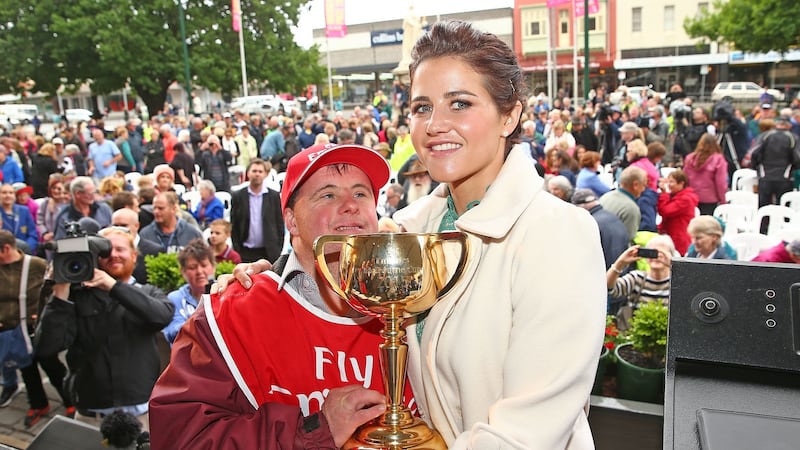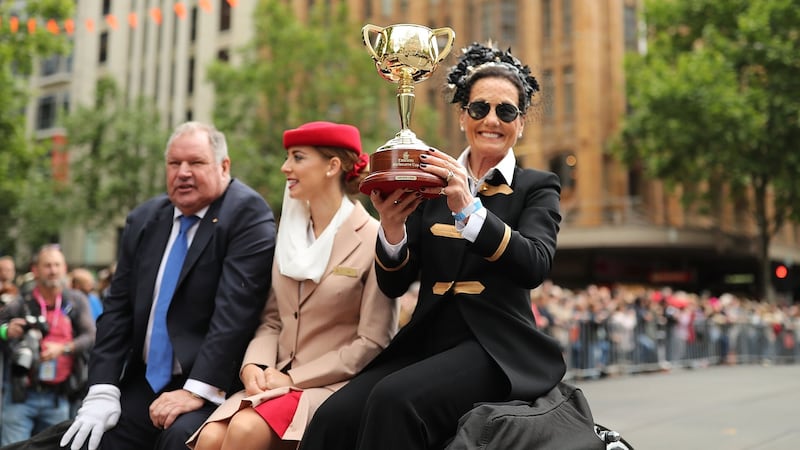On Monday, the race that stops a nation also, once again, managed to divide a nation. The annual Melbourne Cup parade brings the city to a standstill as tens of thousands line Swanston and Bourke streets to catch a glimpse of the 18-carat Cup, Fashions on the Field finalists, jockeys and trainers alike. Although outnumbered, the parade also notoriously draws a swathe of protesters, who compensate with megaphone-delivered messaging about the cruelty of the thoroughbred industry and the rhythmic chant of “horse racing kills”.
This year, the march begins in Bourke Street mall, where some have been gathering since the early hours of the morning. Others have travelled far and wide for the occasion. Ann, from Adelaide, left her home last Saturday week, catching the Indian Pacific rail to Sydney, before jumping on a PNO cruise ship to Melbourne to attend her first Cup. She and six friends splurged $950 to spend the day in the Makybe Diva tent – who Ann points out is a "good South Australian horse". For the record, she says she will be backing Kathy O'Hara's Single Gaze, citing her desire to see another female jockey triumph. "I was just so rapt for Michelle Payne [the 2015 winner]" she says. "We won $40 in the casino in Sydney, so we'll be putting our money on Kathy!"

Erina, from the central coast, has also travelled to Melbourne via cruise ship (this time on the Pacific Explorer) to soak up the atmosphere. Unlike Ann, she is not a debutant – she was at Flemington in 1961 to see Lord Fury win. She says it has long been on her bucket list to return – and for the occasion will be wearing an apricot-coloured summer suit bought for her by her daughters. Although she has fond memories of 61, she says there’s one moment in particular she won’t soon forget – seeing a horse shot dead after its hoof was “sliced off”. “It was horrible,” she says. “I’ll always remember that.”
The pall of animal cruelty hangs over the parade, most notably when the colourful procession reaches its culmination at Federation Square. There, a group of at least 100 protesters are gathered, a large contingent from the Coalition for the Protection of Racehorses.
Campaign manager Elio Celotto is visibly emotional when he speaks with Guardian Australia. He says he is here this year, and every year, to be a voice for racehorses. “We’ve been demanding a retirement plan for racehorses since 2013,” he says. “The racehorse is totally exploited by the industry. They don’t have a retirement plan for them and, as a result, most are sent to slaughter.”
Celotto says that while deaths at the Cup are shocking, they are indicative of a much larger problem.
“Deaths occur all year round,” he says. “Approximately 125 horses are killed every year, one horse every 2.4 days.
“It’s because they’re pushed way too far. That’s why we see so many horses ‘disappear’ – the racing industry simply does not account for them properly. The industry relies on a model of turning over thousands of horses every year, simply for the sake of profit, and we think it’s unconscionable that that is allowed to occur.”

Gonzalo Villanueva, a tutor at the University of Melbourne, is also attending the parade in protest, citing a consistent history of horses dying at the Melbourne Cup (including two in the first race in 1861). He says he sees himself in a tradition of protesters who have long been opposed to horse racing, “whether it’s because of gambling, antisocial behaviour, or cruelty to animals”.
“There’s a lot of money behind the horse racing industry, lots of vested interest in it being successful,” he says. Asked why he thinks the public is still so enamoured by the race, Villanueva says there are “entrenched economic and cultural reasons”.
“The gambling industry is closely tied with horse racing, and other sports,” he says. “So it’s hard to challenge. We feel we are the minority here, that we’re not taken seriously. But if only people could see for themselves the lives horses live, the knackeries, the way they’re killed, I don’t think a lot of people would accept that.”
Cries of “horse racing kills” continue as officials gather among a large crowd at Federation Square for a press conference. Shane Anderson, a prominent racing journalist who leads proceedings, apologises for the noise, before adding – with an unfortunate turn of phrase – that he hoped the protest “would die off eventually”.
But much like the Cup – and the associated gambling, antisocial behaviour and cruelty to animals – the protests are unlikely to disappear any time soon. – Guardian service











